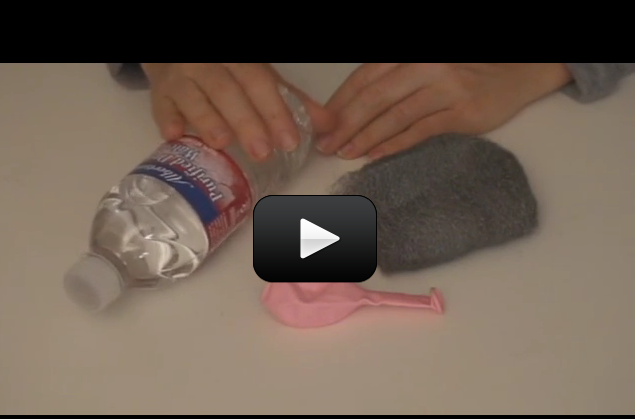Mars is coated with iron oxide, which not only covers the surface but is also present in the rocks made by the volcanoes on Mars.
Today you get to perform a chemistry experiment that investigates the different kinds of rust and shows that given the right conditions, anything containing iron will eventually break down and corrode. When iron rusts, it’s actually going through a chemical reaction: Steel (iron) + Water (oxygen) + Air (oxygen) = Rust
Materials
- Four empty water bottles
- Four balloons
- Water
- Steel wool
- Vinegar
- Water
- Salt


At the hardware and grocery store. Make sure to use the kind WITHOUT soap added in (example: “S.O.S.” cleaning pads are not acceptable to use.)
Where can I find steel wool?
The chloride in the salt combines with the metal to rust it. You should be dumping out the water, but try it both ways to see if it makes a difference in your results!
Also, How come we added salt? Does it aid the corrosion of the steel?
Hi there! In the video you had us soak the steel wool in water and then dump out the liquid, leaving the steel wool inside the bottle, capped with a balloon. In the written instructions, however, you didn’t mention whether or not we should discard the liquids. We are trying the video method of dumping the liquids out. Which method should we have followed? or does it matter?
Yes, as long as it’s not coated so it can rust easily.
will normal steel work.
No, never ever eat anything you do experiments with!
after we do it can we take out the same type of salt as last and then eat it??!!
No, salt and sugar are two totally different molecules.
cool! but does sugar work
Yes, that’s right Boris! One of the reactions creates a vacuum inside the bottle (it consumes more gas volume than it produces), and one will expand the balloon the most. The others may or may not inflate the balloon, depending on the size of your container, the size of the balloon, and how much steel wool and liquid you used. Great observations!
I know this experiment is a little complicated… for ones like these I write them in my science notebook so I can keep it straight which thing did what during the experiment. 🙂
Steel wool is a fine-mesh ball of steel fibers. You can find it at a hardware store. The ones sold in the grocery stores have soap inside (for scrubbing pans), which will contaminate your experiment.
we did the experiment and have ended up with the same results as the ones reported by April S.. Were not all of the balloons supposed to inflate somewhat due to the CO2 gas created? I understand there was supposed to be a difference, but only one bottle had the balloon inflate, and then deflate, the rest are just hanging over the side of the bottles, and one (don’t remember which at this point, not in front of it atm.) is sucked completely into the bottle. Did we somehow create a vacuum instead of producing the gas byproduct? Why/how would that happen?
What is steel wool?
Yes, that’s right!
Is the gas that is generated carbon dioxide?
Your container (bottle + balloon) might have been too big to see any effects – the reaction may have not generated enough gas to fill the bottle and balloon so it inflates. Try with a smaller balloon or tape part of the balloon off to reduce the size… or leave it for a couple days to see if it is still generating gas. Keep trying – science is like this sometimes! Your experiment didn’t ‘fail’… you just got a result you weren’t expecting… this happens ALL the time to scientists! 🙂
This is a GREAT opportunity to show the kids how to deal with things like this… get them curious about what happened and ask them what they can change, and how they expect the change to affect their experiment. And then try again… and again… resilience and determination are wonderful traits to cultivate in students.
We did this experiment without much success. Only one of our balloons got sucked into a bottle and all the others just flopped over 🙁
I was thinking that we used balloons that were too big; otherwise, I’m not sure why our experiment failed.
April
Santa Cruz
This experiment is about generating a gas through a chemical reaction. The balloon will show you how much gas is generated – the larger the balloon, the more gas was produced. The rust (iron oxide) is the name of the reaction taking place between the steel wool and the liquids.
We haven’t tried this yet, just watched the video. I’m confused though. You don’t mention rust in the video, but it’s called rusty balloon. Is the balloon supposed to get rusty or not? Is the experiment about rust or pressure generated?